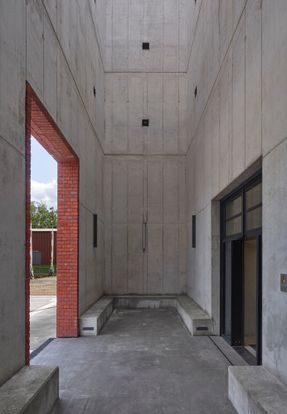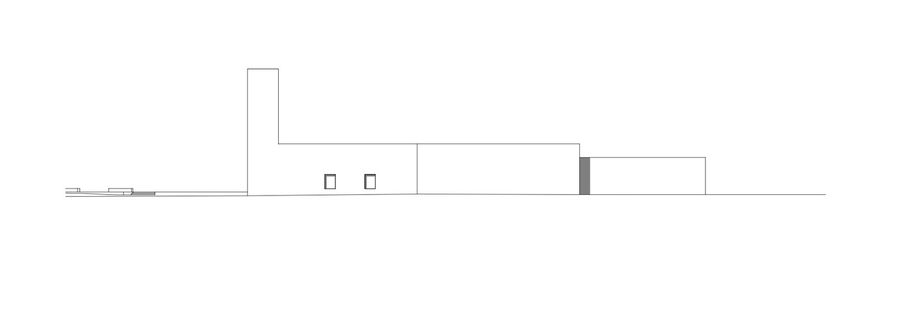CONSTRUCTION SITE MANAGEMENT
Vervoorts & Schindler Architekten Bda
ELECTRICAL PLANNING
Isw Ingenieur Gmbh, Schmidt & Willmes
MANUFACTURERS
Geberit, Bega, Domoferm, Fsb Franz Schneider Brakel, Geze, Grohe, Inotec, Lightnet, Renz-solutions, Wagner-ewar, Dormakaba, Neko Lighting Ag, Schäfer, Schüring Ziegel
PROJECT MANAGER
Simone Boldrin
FIRE SAFETY
Hagen Ingenieurgesellschaft Für Brandschutz Mbh
COMPETITION TEAM
Kilian Teckemeier, Katharina Laekamp, Guido Porta, Roberto Aruta; Jörg Jakubczak, Niklas Bahners
BUILDING SERVICES AND ELECTRICAL PLANNING
Isw Ingenieur Gmbh - Schmidt & Willmes
BUILDING PHYSICS/ACOUSTICS
Zpp Ingenieure Ag
BUILDING SERVICES
Isw Ingenieur Gmbh, Schmidt & Willmes
DEPUTY PROJECT MANAGER
Roberto Aruta
ACOUSTICS
Zpp Ingenieure Ag
YEAR
2019
LOCATION
Bochum, Germany
CATEGORY
Museum
Text description provided by architect.
With its sculptural reception building, the museum is part of the network of industrial-cultural monuments of the region, which, with its mines, gasometers and railway facilities, is reminiscent of the history of mining and industry.
In the immediate vicinity of the railway museum are the German Mining Museum Bochum and the Zollverein Coal Mine Industrial Complex, which has been a UNESCO World Heritage Site since 2001.
At the same time, the new building sees itself as a laboratory for the future technology railway. As a new landmark, a striking brick tower shows the entrance to the museum.
The new building of the reception area is part of a new conception of the museum to make the offers and the presentation possibilities more attractive. The reorganized museum becomes a place that connects past, present and future.
Max Dudler sees it as a future-oriented laboratory that, with its multitude of exhibits, offers an understanding of the railroad's success story as well as the region's historical identity. The new reception building becomes an architectural manifesto for a new, sustainable era of the railway.
The single-storey brick building, which will welcome visitors in the future, blends into the museum grounds with a towering entrance front as a sculptural body.
From the flowing transition to the upstream museum platform arises a figure that traces the momentum of the surrounding tracks in their dynamics.
The presence of the architecture is strengthened by the uniformity of the material.
Concrete, steel and clinker as the typical materials of historical industrial architecture pick up the echo of the old railway buildings and of the Ruhr area, characterized by heavy industry and perpetuates it into contemporary architecture.
The monolithic-looking tower functions as a radiant signal and at the same time serves as a foyer for the museum.
It provides a view into the narrow, elongated museum space, with a large window at one end, offering an open view onto the tracks.
The linear and seemingly infinite vista of railway tracks is set spatially in scene here.
In the tower, the horizontal axis is reflected in the vertical: the completely empty space, open at the top, directs the visitor’s gaze upwards.
On their way to the entrance to the museum site, visitors walk through the elongated hallway of the new build. Conceived as a gallery its first exhibits are on show.
The industrial character of the interior is characterised by rough, exposed concrete walls and visible technical installations that emphasise the linear flow of space. The oak furnishings, specially designed for space, form an exciting contrast to the cool feel of the concrete, referencing the material of old railway sleepers.
The Railway Museum in Bochum-Dahlhausen was founded in 1977 and is one of the largest museums of its kind in Germany. Over 120 exhibits spanning the period from 1853 to the present day, illustrate the development of the railway system in an area of around 46,000m.
Technical progress is documented not only by the historic carriages and locomotives but also by the various listed buildings, such as the roundhouse with turntable and the water tower. The new reception building is part and parcel of a new museum concept to enable upgrading and new presentational options, increasing its attractiveness to visitors.





















